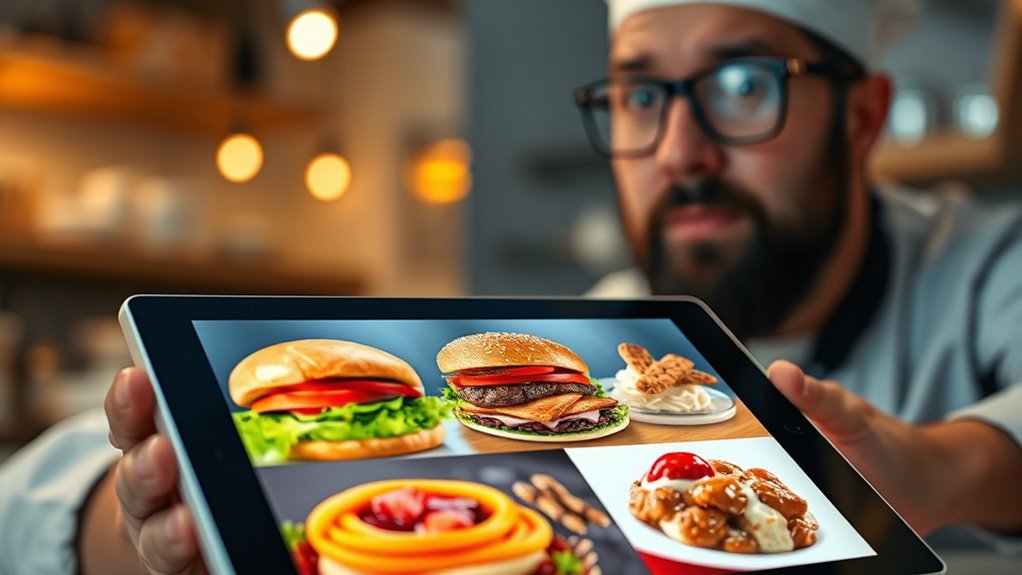When using AI-generated food images, it’s essential to prioritize authenticity and transparency. Always verify images honestly represent the food’s true appearance and qualities to maintain consumer trust. Clearly disclose AI’s role and obtain proper permissions if using others’ work. Be aware of cultural sensitivities and avoid stereotypes, while actively working to minimize bias. By embracing responsible practices, you reflect ethical standards and build credibility—continue to explore how to do this effectively.
Key Takeaways
- Ensure AI-generated food images accurately reflect the actual product to maintain consumer trust and authenticity.
- Clearly disclose AI involvement and label images to promote transparency and ethical content creation.
- Respect intellectual property rights by obtaining permissions and crediting original creators when using food visuals.
- Address algorithm bias by implementing guidelines and regular audits to prevent misleading or stereotypical representations.
- Develop and adhere to regulatory standards and accountability frameworks to ensure responsible and ethical use of AI in food imagery.
Authenticity and Truthfulness in Food Representation

When it comes to AI-generated food images, authenticity and truthfulness are essential for maintaining consumer trust. You need to guarantee that the images genuinely represent the food, reflecting its true appearance and qualities. Food authenticity isn’t just about accuracy; it’s about respecting consumers’ expectations and avoiding deception. Visual honesty is key—images should accurately depict the textures, colors, and portion sizes without exaggeration or manipulation. If your food images appear overly perfect or misleading, you risk undermining your credibility. Ensuring authenticity in AI-generated visuals builds trust and fosters transparency. Remember, consumers value honesty and are more likely to engage with brands that prioritize truthful representation over gimmicks or false impressions. Maintaining these standards helps uphold integrity in food marketing. Additionally, incorporating high-quality visuals that accurately reflect the product can significantly enhance consumer confidence and satisfaction. Furthermore, embracing ethical considerations in AI-generated imagery emphasizes the importance of honesty and responsible marketing practices. Recognizing the potential vulnerabilities and biases inherent in AI models is also crucial to prevent unintentional misrepresentation and to promote trustworthiness in visual content. Incorporating industry standards can help ensure that AI-generated images meet established guidelines for authenticity and ethical marketing, especially considering the importance of nutrient information in food representation.
Transparency About AI Use in Content Creation
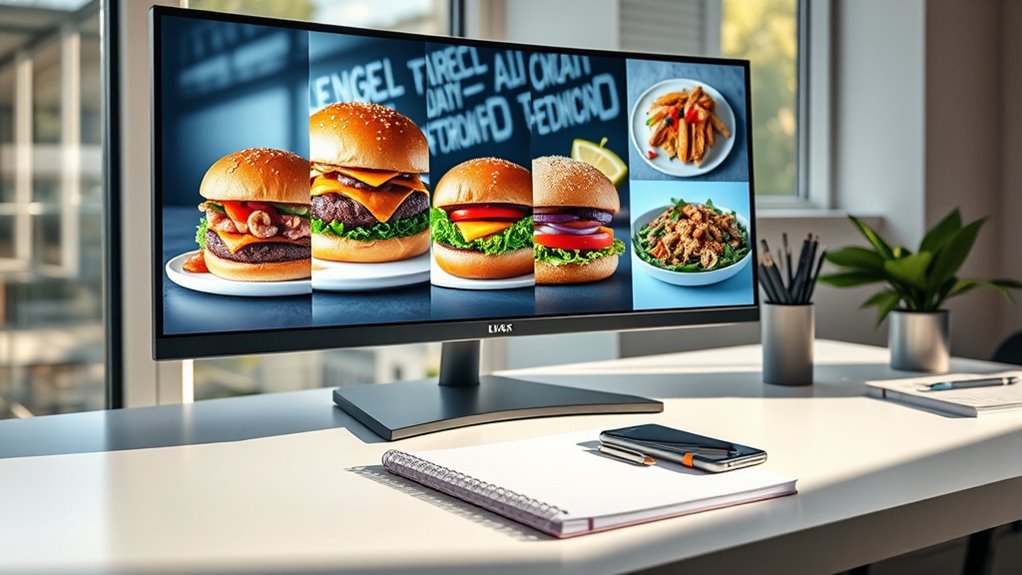
You should clearly disclose when AI helps create your food images to maintain trust with your audience. Using transparent labels and ethical transparency practices shows you’re committed to honesty. This openness encourages viewers to understand and appreciate your content’s true origins. Embracing AI-driven insights can further enhance how you communicate your use of technology to your followers. Additionally, understanding the importance of content authenticity can help build long-term credibility with your audience. Incorporating home decor aesthetics into your presentation can also elevate the visual appeal and authenticity of your food visuals, particularly when considering how electric bikes and their features influence modern lifestyles and visuals. Being aware of grocery savings strategies can also inspire more genuine content by highlighting cost-effective and sustainable food choices.
Disclosing AI Assistance
Disclosing AI assistance in food image creation is essential for maintaining transparency and building trust with your audience. When you openly share that AI contributed to your visuals, you demonstrate integrity and respect for your viewers’ right to know. This transparency highlights your commitment to visual ethics, ensuring your followers understand the role of AI creativity in your content. By clearly disclosing AI involvement, you also help set realistic expectations about the images’ origin and authenticity. Avoiding ambiguity about AI use not only fosters trust but also aligns with ethical standards in digital content production. Incorporating user privacy measures can further promote responsible AI deployment and protect your audience’s interests. Recognizing angel number soulmate patterns can also inspire more authentic and meaningful content creation, emphasizing honesty with your viewers. Additionally, understanding the impact of cookies on user experience can help maintain transparency about data collection practices related to content sharing. Moreover, acknowledging water-related considerations in AI image generation can ensure environmental sustainability and responsible resource use. Ultimately, being upfront about AI assistance emphasizes your dedication to honesty, supports responsible innovation, and encourages a more informed and ethical consumption of AI-generated food images.
Clear Image Labeling
Clear labeling of AI-generated food images is essential for maintaining transparency and fostering trust with your audience. When you label images clearly, you acknowledge any image manipulation that may have been involved, ensuring your viewers understand that the visuals might not be entirely authentic. This transparency helps uphold visual authenticity, showing you’re honest about how the images are created. If you omit labeling, it can lead to misconceptions about the food’s appearance and quality. By being upfront, you prevent potential misunderstandings and demonstrate integrity in your content. Clear image labeling not only respects your audience’s right to accurate information but also reinforces your credibility as a responsible content creator. Ultimately, transparency about AI use encourages an honest relationship with your viewers. Additionally, understanding the importance of content transparency can help you navigate evolving standards and maintain compliance with industry best practices. Promoting visual authenticity through proper labeling also supports ethical practices in digital content creation. Moreover, this approach can help mitigate potential misinformation, especially in the context of rapidly evolving arcade machine technologies and gaming content, and build long-term trust with your audience. Recognizing the role of Bitcoin News Day insights can further inform responsible content practices in the digital space.
Ethical Transparency Practices
Maintaining ethical transparency about AI use in content creation is essential for building trust and credibility with your audience. By clearly disclosing when AI has contributed to food images, you respect your viewers’ right to know. Transparency fosters honest artistic expression and shows your commitment to integrity. It also highlights your awareness of technical innovation, demonstrating that you’re leveraging advanced tools responsibly. Being upfront about AI involvement encourages open dialogue and sets a standard for ethical practices within your industry. This honesty not only strengthens your reputation but also reassures your audience that your content isn’t misleading. Additionally, understanding the security zone info associated with AI-generated content can help you implement best practices for safeguarding your work and maintaining user trust. Moreover, being aware of Fin and Forage principles can guide how you incorporate traditional knowledge and sustainable practices into your content. Recognizing the importance of self-awareness can further enhance your ethical decision-making process. Ultimately, transparency about AI use ensures your creative process aligns with ethical principles while embracing the evolving landscape of technological innovation.
Respecting Intellectual Property Rights of Original Food Creators

Respecting the intellectual property rights of original food creators is essential to guarantee fair recognition and prevent unauthorized use of their work. You must acknowledge that food presentations and photos are protected by intellectual property laws, emphasizing creative ownership. To do this effectively, consider these steps:
Respect food creators’ rights by crediting and obtaining permission for images and reproductions.
- Always credit the original creator when using or referencing their work.
- Obtain necessary permissions before reproducing or modifying food images.
- Avoid copying or closely mimicking original food visuals without permission.
- Use licensed or royalty-free images when creating AI-generated visuals to respect intellectual property rights.
Avoiding Deception Through Misleading Visuals
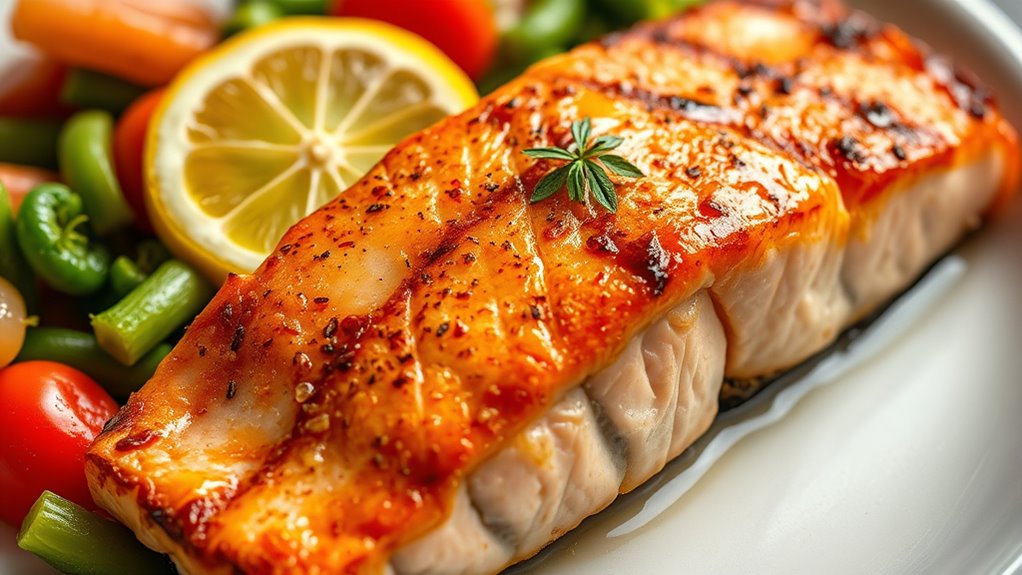
You need to guarantee that your AI-generated food images accurately represent the actual product to prevent misleading viewers. Misrepresentation risks can damage trust and credibility if images suggest qualities that aren’t true. Verifying authenticity is essential to maintain honesty and avoid deceiving your audience.
Misrepresentation Risks
When AI-generated food images are designed to look more appealing or idealized than the real dish, they can easily mislead consumers. This misrepresentation risks creating false expectations about the food’s actual appearance and quality. To avoid this, consider these points:
- Overstated food styling can exaggerate textures and colors, setting unrealistic standards.
- Enhanced visual appeal might distort the true portion size or ingredients.
- Misleading images may influence customers’ purchasing decisions based on false impressions.
- Consumers could feel deceived if the actual dish doesn’t match the advertised image, eroding trust.
Being transparent about the use of AI and avoiding overly perfect visuals helps prevent deception. Focus on accurate representations to maintain integrity and foster honest consumer relationships.
Authenticity Verification
To prevent consumers from being deceived by AI-generated food images, verifying their authenticity is essential. You should prioritize transparent food styling that accurately reflects the real dish, avoiding exaggerated or misleading visuals. Authenticity verification involves cross-checking images with actual food photos or providing context that clarifies whether images are AI-generated. This maintains integrity in visual storytelling, ensuring your audience isn’t misled about the product’s appearance or quality. Use clear labeling when AI is involved in creating images, and consider including behind-the-scenes insights to build trust. By committing to genuine representations, you help foster consumer confidence and uphold ethical standards in food marketing, reducing the risk of deception and ensuring your visuals serve as honest reflections of the food you present.
Consumer Trust and Ethical Marketing Practices

Maintaining consumer trust requires honest and transparent marketing practices, especially when it comes to AI-generated food images. To guarantee trust, consider these key points:
- Clearly label AI-generated images to avoid misleading consumers about food quality or aesthetic appeal.
- Showcase authentic images alongside AI visuals to maintain transparency.
- Focus on accurate representation of food quality, avoiding exaggerated or deceptive visuals.
- Educate consumers about how AI images enhance marketing without compromising trust or authenticity.
Impact of AI-Generated Images on Culinary Professionals
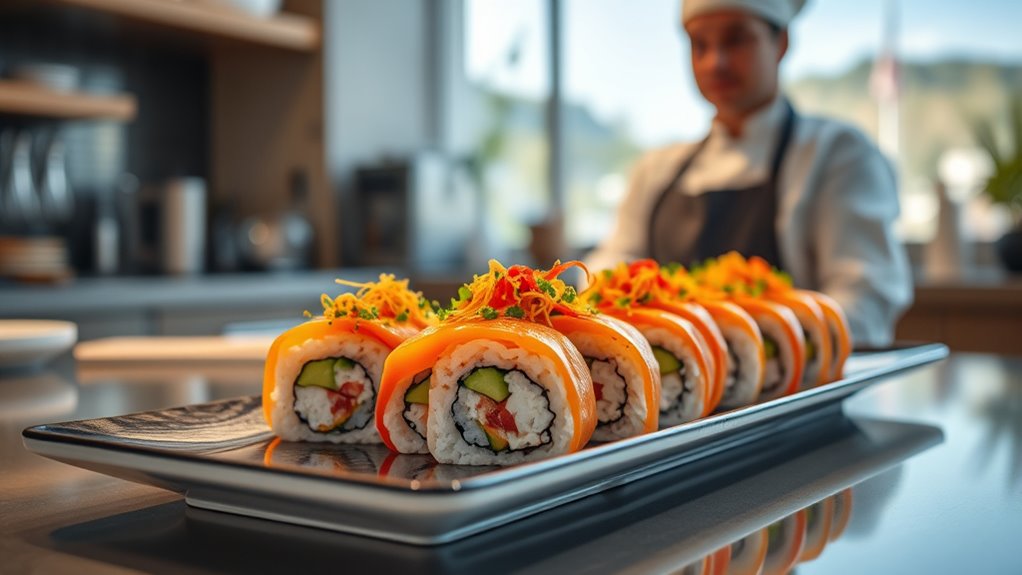
AI-generated images are transforming how culinary professionals showcase their creations, presenting both opportunities and challenges. You can now craft visually stunning dishes that appeal to diverse audiences through cross-cultural influences, broadening your culinary reach. These images enhance the sensory appeal of your food, making dishes look more appetizing and innovative. However, reliance on AI visuals may also impact your authenticity and originality, leading to questions about artistic integrity. You might find it easier to attract clients or followers with striking AI-generated images, but balancing this with genuine culinary skills is essential. As AI continues to influence food presentation, you must consider ethical implications, ensuring that your use of AI enhances rather than detracts from your credibility and respect for culinary traditions.
Cultural Sensitivity and Respect for Food Traditions
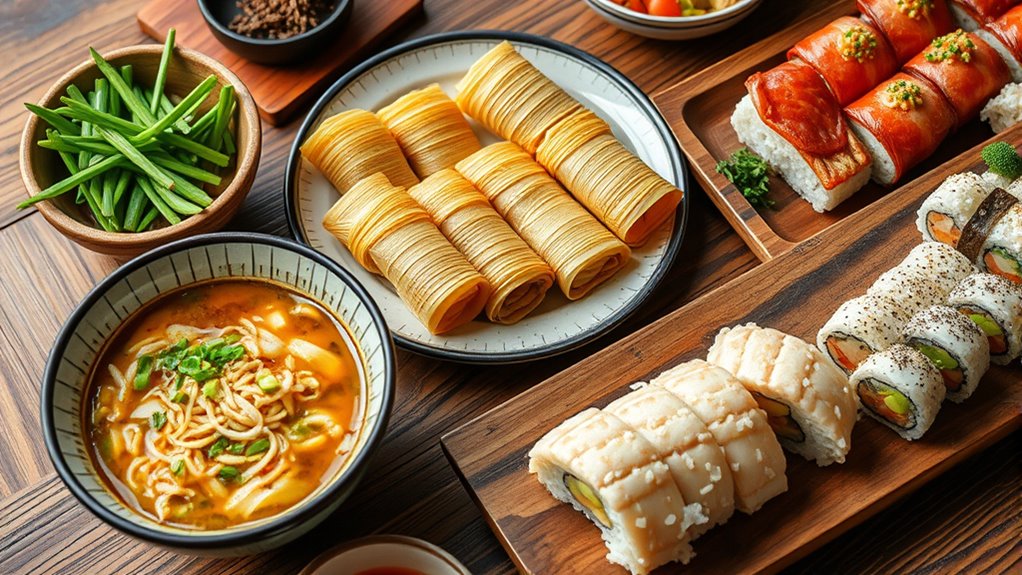
When creating AI-generated food images, you need to respect the cultural significance behind certain dishes and traditions. Avoid stereotypes that can misrepresent or trivialize these food practices. By doing so, you show respect for different cultures and help promote authentic and meaningful representations.
Honoring Cultural Significance
Understanding and respecting the cultural significance of food is essential when creating AI-generated food images. To guarantee cultural appreciation, you should recognize the traditional significance behind dishes and avoid misrepresenting or trivializing them. Here are four ways to honor this:
- Research the origins and cultural context of the food.
- Use authentic ingredients and presentation styles.
- Avoid stereotypes that could distort cultural meanings.
- Consult cultural experts or community members when possible.
Avoiding Stereotypes
To respect food traditions and promote cultural sensitivity, it’s essential to avoid stereotypes that can distort or oversimplify a culture’s culinary identity. Stereotype reinforcement occurs when AI-generated images rely on clichés, reducing diverse cuisines to generic or inaccurate representations. This can lead to cultural misrepresentation, where specific ingredients, preparation styles, or presentation methods are misused or exaggerated. By carefully selecting images that authentically reflect a culture’s food practices, you help preserve its integrity and prevent harmful misconceptions. Avoiding stereotypes isn’t just about accuracy; it’s about honoring the richness and uniqueness of culinary traditions. When creating or sharing AI food images, prioritize culturally accurate depictions that respect the diversity and complexity of each cuisine.
Addressing Potential Biases in AI Food Imagery
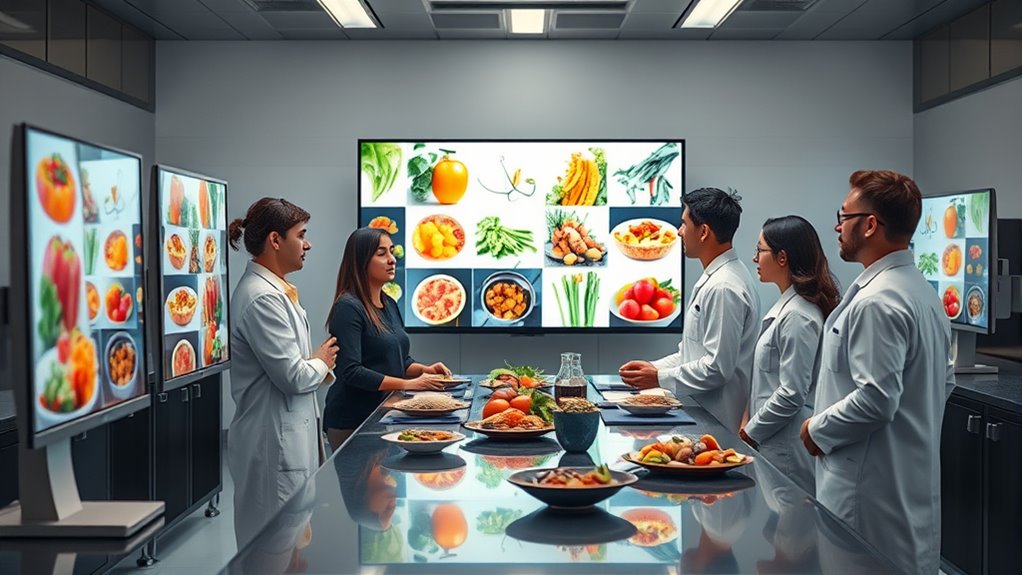
Addressing potential biases in AI food imagery is crucial to guarantee fair and accurate representations across diverse cuisines, cultures, and dietary preferences. You need to focus on algorithm fairness to prevent skewed portrayals that favor certain foods or regions. Bias mitigation techniques help identify and correct distortions in training data, ensuring inclusivity. Here are four key steps:
- Regularly audit training datasets for cultural and dietary diversity.
- Incorporate diverse sources to reduce representation bias.
- Use fairness metrics to monitor algorithm outputs consistently.
- Involve diverse stakeholders to identify and address blind spots.
Responsibilities of Content Creators and Marketers
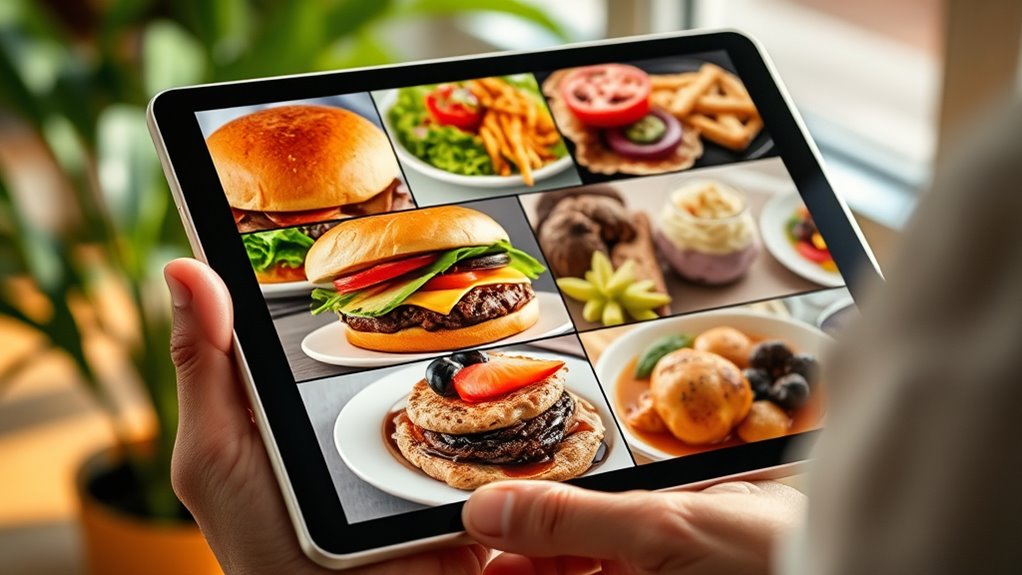
As AI-generated food imagery becomes more prevalent, content creators and marketers carry the responsibility of ensuring these visuals are accurate, respectful, and inclusive. You must prioritize honest food styling that reflects real dishes without exaggeration or manipulation. This includes being transparent about the use of AI and avoiding misleading representations that could deceive consumers. Additionally, ingredient sourcing should be portrayed responsibly; avoid implying that any ingredient is ethically sourced or sustainable unless it truly is. Your role also involves respecting cultural diversity and avoiding stereotypes in food depiction. By maintaining integrity, you build trust with your audience and uphold ethical standards. Ensuring your AI-generated images align with real-world practices supports transparency and promotes a more honest food industry.
Future Ethical Challenges and the Need for Regulation
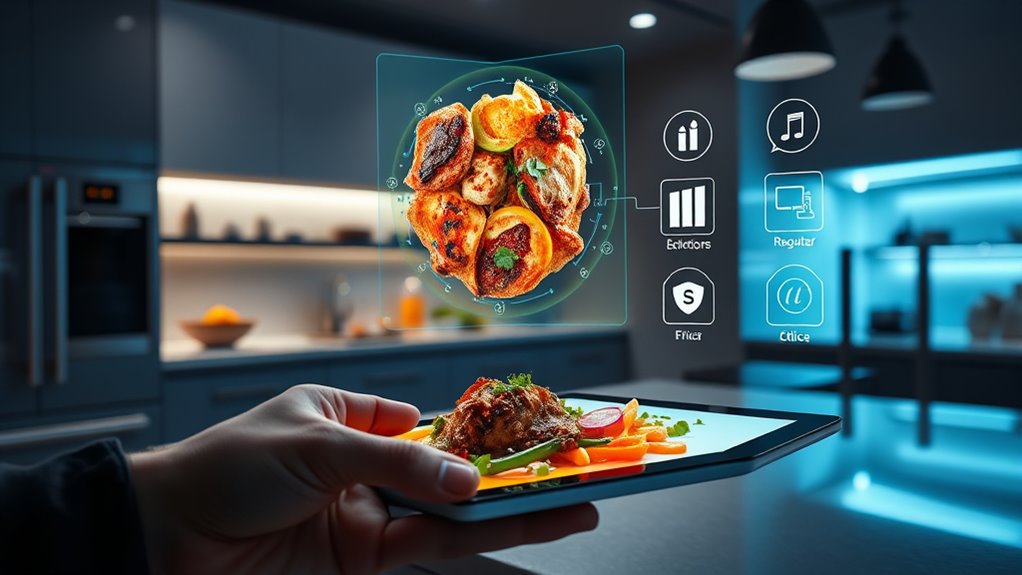
The rapid advancement of AI-generated food imagery presents significant ethical challenges that demand proactive regulation. You need to address issues like algorithm bias, which can skew representations and mislead consumers. Without proper oversight, regulation gaps may allow deceptive practices to flourish. To navigate these challenges, consider these points:
Proactive regulation is vital to combat AI food imagery bias and ensure ethical, transparent standards.
- Closing regulation gaps to ensure consistent ethical standards.
- Developing guidelines to minimize algorithm bias and promote accurate depictions.
- Implementing transparency measures for AI algorithms used in food imagery.
- Establishing accountability frameworks for content creators and platforms.
Frequently Asked Questions
Can Ai-Generated Food Images Influence Consumer Perceptions of Authenticity?
AI-generated food images can considerably influence your perception of authenticity. When you see these images, you might question whether they truly reflect real food, affecting your perceived authenticity. This, in turn, impacts your consumer trust, as you may doubt the honesty of the visuals. If AI images are convincing, they can enhance trust; if not, they might diminish your confidence in the product or brand.
How Do AI Images Impact the Livelihoods of Professional Food Photographers?
Imagine capturing a vibrant, steaming dish, each detail reflecting your skill. Now, AI-generated images threaten your artistic authenticity, making it harder for clients to recognize your unique touch. As AI tools create perfect visuals effortlessly, your skill erosion becomes evident, risking your livelihood. You must adapt, blending your artistry with new tech to maintain value, or face a future where your craftsmanship is overshadowed by automated perfection.
Are There Legal Risks Associated With Using Ai-Created Food Visuals?
When you use AI-created food visuals, you face legal risks related to intellectual property and liability concerns. You might unintentionally infringe on copyrighted images or proprietary designs, which could lead to lawsuits. Additionally, liability concerns arise if the AI-generated images misrepresent the food or cause consumer deception. To stay protected, verify you have proper rights or licenses and confirm that your visuals accurately represent the product.
How Can AI Bias Affect Representation of Diverse Cuisines?
Imagine your food images as a mirror reflecting diverse cuisines. AI bias can distort this mirror, reinforcing cultural stereotypes and misrepresenting ingredients. You might unknowingly promote narrow views, overlooking authentic details. To avoid this, guarantee your AI models are trained on diverse, accurate data. By doing so, you help portray each cuisine with respect, capturing true ingredient accuracy and celebrating cultural richness instead of perpetuating misconceptions.
Should Consumers Be Informed if Food Images Are Ai-Generated?
You should be informed if food images are AI-generated because transparency is vital for maintaining consumer trust. When you know the images are artificial, you’re better equipped to interpret them accurately, avoiding misconceptions. Transparency fosters honesty and helps you make informed decisions, ensuring that brands prioritize ethical standards. Ultimately, clear communication about AI-generated images supports a trustworthy relationship between consumers and content creators.
Conclusion
By balancing honesty with innovation, you can build trust and foster fairness in AI-generated food imagery. Prioritize transparency, respect traditions, and avoid deception to uphold ethical standards. Embrace evolving regulations and remain vigilant against biases, ensuring your creations celebrate authenticity rather than illusion. When you act responsibly and respectfully, you not only protect your reputation but also promote a positive, principled food future filled with integrity and inclusivity.
